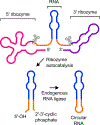Noncoding RNAs: biology and applications-a Keystone Symposia report
- PMID: 34791665
- PMCID: PMC9808899
- DOI: 10.1111/nyas.14713
Noncoding RNAs: biology and applications-a Keystone Symposia report
Erratum in
-
Erratum for.Ann N Y Acad Sci. 2022 Jan;1507(1):171. doi: 10.1111/nyas.14751. Ann N Y Acad Sci. 2022. PMID: 35061911 No abstract available.
Abstract
The human transcriptome contains many types of noncoding RNAs, which rival the number of protein-coding species. From long noncoding RNAs (lncRNAs) that are over 200 nucleotides long to piwi-interacting RNAs (piRNAs) of only 20 nucleotides, noncoding RNAs play important roles in regulating transcription, epigenetic modifications, translation, and cell signaling. Roles for noncoding RNAs in disease mechanisms are also being uncovered, and several species have been identified as potential drug targets. On May 11-14, 2021, the Keystone eSymposium "Noncoding RNAs: Biology and Applications" brought together researchers working in RNA biology, structure, and technologies to accelerate both the understanding of RNA basic biology and the translation of those findings into clinical applications.
Keywords: Xist; circRNA; lncRNA; noncoding RNA; nuclear condensate; phase transition; piRNA; transcription.
© 2021 New York Academy of Sciences.
Figures








References
-
- Mattick JS & Makunin IV 2006. Non-coding RNA. Hum. Mol. Genet 15 Spec No 1: R17–29. - PubMed

